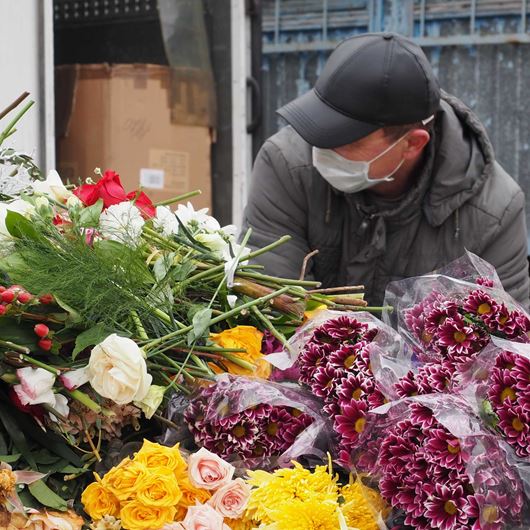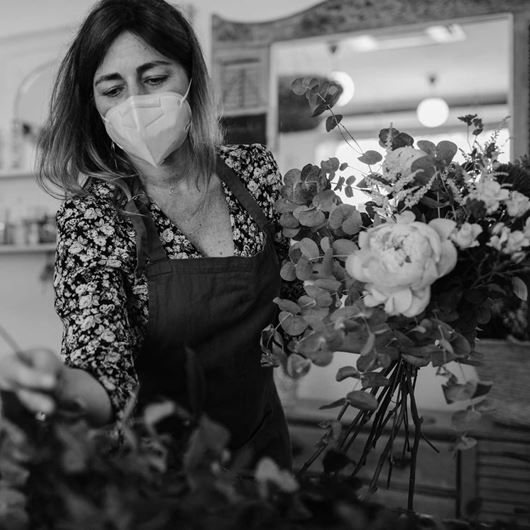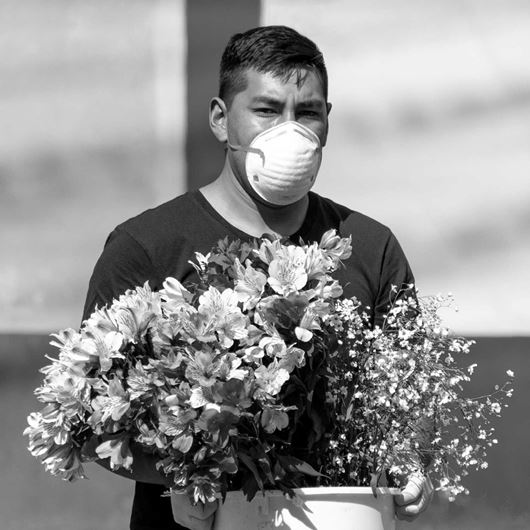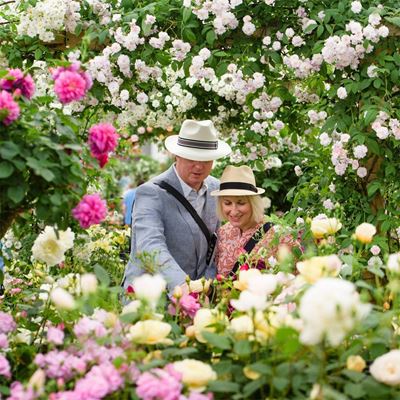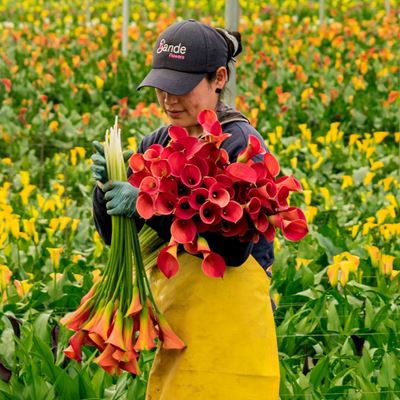As we continue to maneuver through a post-COVID world with new perspectives, many are balancing a future that embraces all things digital while rekindling relationships with the great outdoors. Helping to bridge the cyber age with a return to nature is Viva Magenta, Pantone's 2023 Color of the Year.
A Wilting Industry Forecasts a Strong Comeback From COVID-19
By Natalia Reategui, flower.style Writer
It’s no surprise that the COVID-19 health crisis has rattled nearly all aspects of international trade and everyday life. The floral industry has been hit especially hard, with the pandemic wreaking havoc on global supply chains and presenting unprecedented challenges for floral businesses everywhere. With looming concerns surrounding the virus and our socioeconomic well-being, it’s normal to ask—what’s next for the floral industry?
We’ve already seen the pandemic’s effects on the U.S. economy. In Q1 2020, GDP fell by an annualized rate of 5.0%, and in Q2, it fell a record-breaking 32.9%.1 This is the largest economic contraction ever recorded, far outweighing the drops experienced during the Great Depression and Great Recession. Retail florist sales in the U.S. will also likely fall by about 6.8%, from $7.765 billion in 2019 to $7.238 billion in 2020.2 Though we are currently in this recessionary “black hole,” stable economic expansion—with a parallel rise in U.S. florist sales by about 1.6% annually—is projected to occur through 2024.3 These estimates are promising, but it’s clear that our journey to recovery will be a long one.
GROWERS. The pandemic’s impact on the floral industry begins with the farms. In early March 2020, several growers in North and South America, the Netherlands and Africa saw rapid cutbacks in demand due to mandatory border and business closures. In losing their key outlets of distribution almost overnight, many were forced to throw out millions of dollars worth of fresh inventory, place holds on harvesting crops and reduce staff significantly. For orders still flowing in, many growers also struggled to get them in the hands of their customers. Virtually all points along the supply chain, including logistics companies and shippers, have been affected by losses from border closures, reduced flights and transient business shutdowns.
EXCEPTIONS. One exception to the rule, however, applies to supermarket floral departments. Unlike many wholesalers and retail florists, supermarkets have always stayed open. Immediately following the outbreak, flowers that were able to enter the U.S. from South America were sold more at supermarkets than other comparable outlets (i.e., florist shops).4 Among other items—like hoards of toilet paper—now essential on grocery store lists, it seems like there was no better time to buy a bouquet (or two) to boost moods and bring on some smiles.
Nonetheless, this does not mean that mass market suppliers and retailers have been completely immune from COVID’s wrath. John Simko, President and CEO of Sunshine Bouquet Company, a leading supplier of mass market flowers, details the company’s experiences during the onset of the pandemic. “At the beginning, the demand at the store level was always there. The bottleneck was handling the logistics from the supermarkets’ distribution centers out to the stores. Within the first few weeks, we dumped 25 to 30 million stems of flowers because although the demand was there and the shelves were empty, the supermarkets had to make more space on their trucks for food.”
Once Mother’s Day drew nearer, it was a scramble for many to try and get back in business for the holiday—especially given the complications from labor issues and limited space on flights and trucks. “All within four weeks,” says Simko, “we went from ‘we can’t throw it away fast enough’ to ‘how do we ship this faster?’”
WHOLESALERS & RETAILERS. The pandemic-induced shocks on business activities have funnelled through from growers to wholesalers to retail florists. To comply with state regulations and ensure the health and safety of their employees, many U.S. wholesalers and florists were forced to shutdown their services—whether temporarily or permanently.
John Richards, VP of Sales at New Jersey-based Delaware Valley Floral Group, notes that in late March, the company temporarily suspended business operations across their 10 distribution centers in the Northeast. “DVFlora is one of the largest companies in the floral industry, so our employee count exceeded the limit to be eligible for relief under the PPP loan,” he says. “Unlike the vast majority of those in the industry, we received zero federal aid. We therefore had to make some excruciatingly difficult decisions on staff—including permanent and temporary layoffs—given the dramatic and prolonged drop in revenue resulting from the pandemic.”
Even as businesses have reopened, the problems concerning logistics, wavering supply and uncertain demand persist. Some growers have yet to revert back to their pre-COVID production levels, making it hard for wholesalers to satisfy once-normal demands and maintain firm inventory control. Others still find obstacles in delivering merchandise to retail customers. However, to overcome these transportation and supply-related issues, many have successfully pivoted strategies to manage inventory better and fulfill deliveries using alternative methods.
DVFlora attributes their steady recovery to rapid-fire decision making, the efforts of their incredible team and the commitment of their stakeholders. “COVID-19 has helped us perform with greater clarity of thought, speed of execution and willingness to try and implement new strategies,” says Richards. “Prior to re-starting deliveries in early April, we established a direct-ship FedEx program from our farm partners to stores that remained open. We also began a product pickup program at our distribution centers.” Moreover, because of their logistics capabilities and long-term relationships with suppliers, DVFlora was able to maintain a good inventory position even amid the supply chain disruptions.
Much uncertainty also surrounds the state of the events industry. As postponements or cancellations of weddings and other floral-based celebrations continue, wholesalers, florists and independent designers who rely on sales from these activities have taken a heavy hit.
“Colonial House of Flowers, which has been in business since 1968, has never been instantly affected by anything like the pandemic,” says designer Christy Hulsey, former Mayesh Design Star and owner of Colonial House of Flowers based in Atlanta, Georgia. “Since March, events and weekly deliveries have been postponed and cancelled. Staff is cut back, sales are slow and shipments are delayed. It’s been hard.”
Richards also elaborates on COVID’s impact on DVFlora’s event-focused customers. “The pandemic hotspots were occurring in the main markets that we distribute in, so the road to recovery continues to be pretty challenging,” he says. “In some cases, these markets are still affected by restrictions and mandates—especially as they relate to the wedding, event and corporate business that many of our customers depend upon.”
Despite the setbacks, floral industry members have stayed strong and optimistic. In the passing months, most have reopened shop doors, recouped staff members, readjusted business plans and seen upticks in revenue.
Simko reflects on the bright future ahead for Sunshine Bouquet Company and beyond. “I think the industry rallied and responded as well as it could, and our retailers were very supportive of us. It ended up being much less worse than I expected it to be in the very beginning,” he says. “Our sales were also up 20 or 25% coming out of Mother’s Day through the summer. I’m surprised at how quickly it bounced back, how much growth there is and how it doesn’t seem to be stopping.”
Deborah De La Flor, President of the Florida State Florists’ Association and co-owner of De La Flor Florist & Gardens in Cooper City, Florida, recounts her shop’s recovery since the Mother’s Day holiday. “Our COVID experience was initially pretty bad,” she says. “However, as Mother’s Day approached, we really started to pick back up. It turned out to be the best Mother's Day we've had in years. No one seemed to want to risk visiting their relatives, so they sent flowers—lots of them! Business has been fairly good ever since; we’ve just become better at watching our expenses, economizing wherever we can and being more efficient."
Colonial House of Flowers, meanwhile, has turned to underdeveloped divisions to generate sales. “The pandemic pivot has been hard, but I’m grateful that our business plan relies on multiple streams of revenue,” says Hulsey. “Our hard goods division, which hasn’t been efficiently used in the past, was the natural place to turn to during the pandemic. Since being forced to make it work, it’s grown so much—I absolutely love it! I’m also booking more, very small workshops and events, and am freelancing with other designers. They say desperate times call for desperate measures, and we've discovered new ways of doing business this way.”
A HOPEFUL FUTURE. So what’s next for the industry, you ask? We’ll leave you with these final words, taken from a Florists’ Review article about floristry during the Great Depression. “Experience should teach us many lessons, and we now have the opportunity to lay our plans for 1933 on firm bedrock. As Herman D. Schiller, a Chicago retailer, pointed out in his remarks in last week’s issue of The Review, the members of this industry have little reason to become discouraged with the industry itself. Flowers—huge quantities of them—continue to be sold despite the lack of funds in the hands of the rich, middle class and poor. If flowers can be readily sold in times like these…the future for florists is extremely bright.”
We’ll side with Mr. Schiller and say the pandemic’s effects may be strong, but the floral industry is much stronger.
For a related video on this developing story, please click here.
SOURCES
1 Bureau of Economic Analysis. (2020, October). News Release. Retrieved October 14, 2020, from https://www.bea.gov/news/2020/gross-domestic-product-third-estimate-corporate-profits-revised-and-gdp-industry-annual
2,3 Sundale Research. (2020, September). Market Research Reports: Industry Research Reports. Retrieved October 09, 2020, from http://sundaleresearch.com/retailers/state-of-the-industry-florists-in-the-u-s/
4 Produce Marketing Association. (2020, July). US Consumer Sentiment toward Floral Products: Wave 3 July 2020 [PDF]. Delaware: Produce Marketing Association.
